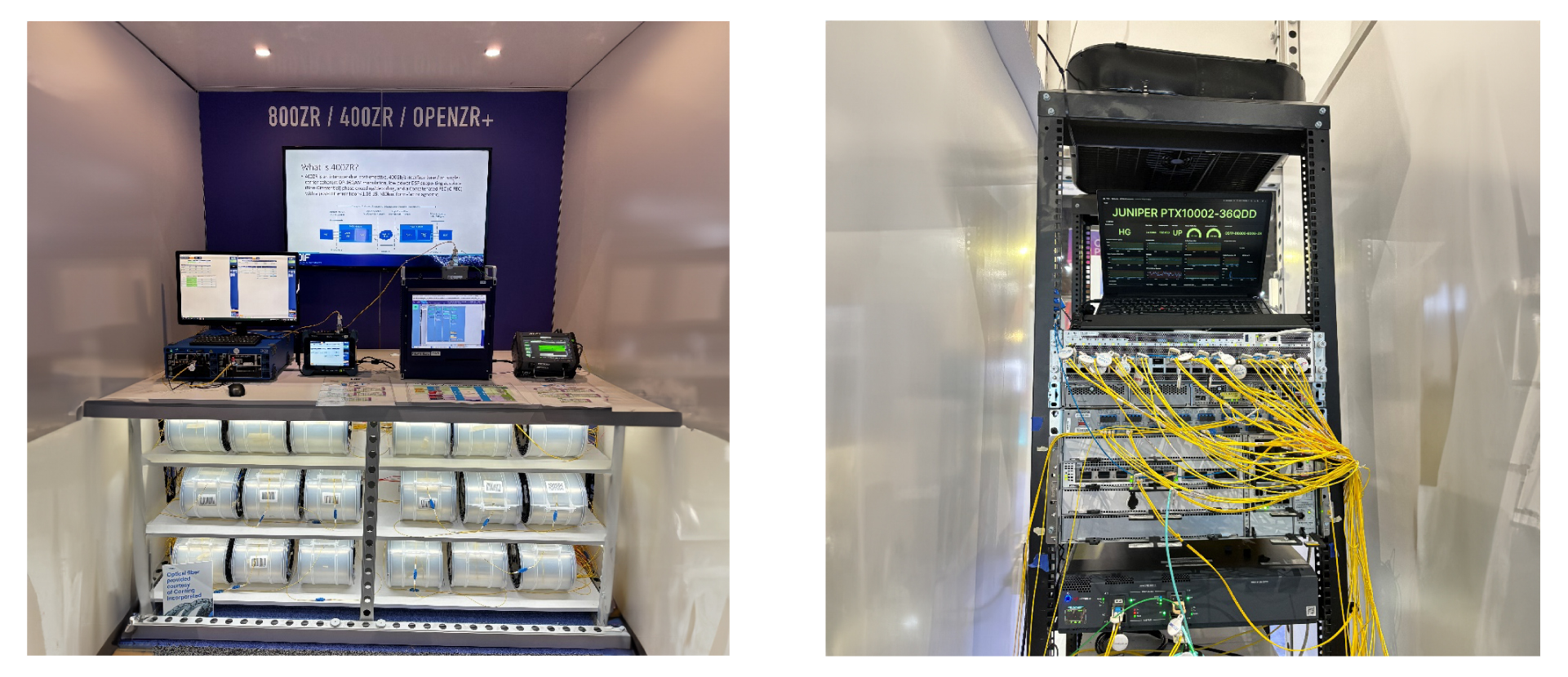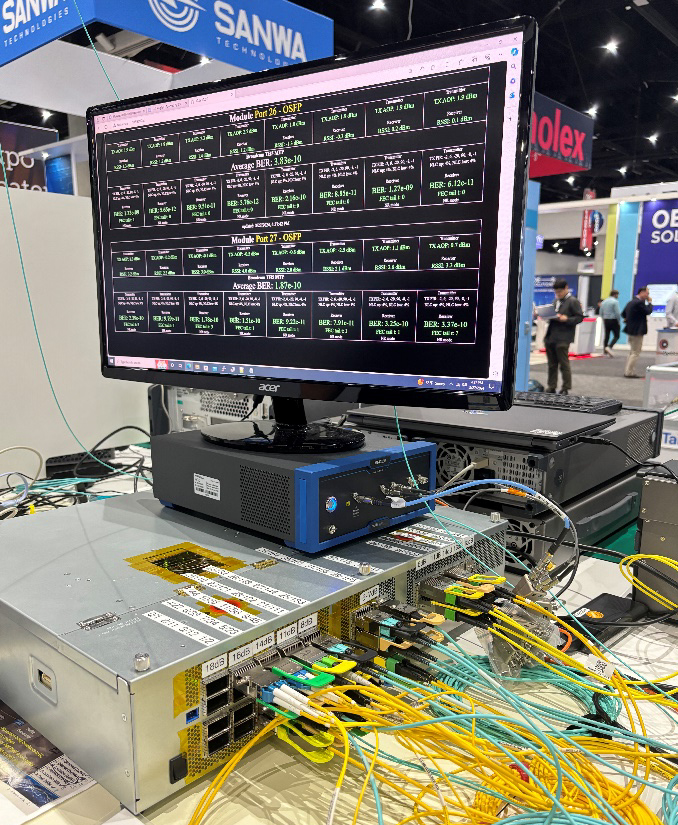OFC 2024: Shaping the Future of Optical Technology
Posted by Tim Yanda and Frank Yang on Apr 1, 2024

Frank and Tim attended OFC 2024 on March 26-28. Below are each of their insights from the conference.
Key OFC Gems from Frank
Many new and exciting developments were showcased at OFC. The optical transceiver industry is continually striving to increase data speed, lower power consumption, and provide better interoperability. I would like to highlight a few key innovations that stood out to me.
High-Speed Data Connectivity
The introduction of 800G ZR/ZR+ Coherent marks a significant advancement in enabler technologies for IP over Dense Wavelength Division Multiplexing (DWDM) applications. The technology doubles the speed of the 400G ZR/ZR+ Coherent and provides a wider range of options for application cases (a.k.a. the list of AppSel). The primary applications for the 400G/800G Coherent are data center interconnects (DCI) and telecom metro networks and long hauls.
The 800G ZR/ZR+ Coherent used nearly 30 watts of power during the demonstration, which will be a challenge for thermal management on host platforms.
Optical Interoperability Forum (OIF) and vendors demonstrated the 400G/800G ZR/ZR+ interoperability:

OSFP vs. QSFP-DD
I'm always curious about which transceiver form factor the market will pick for the next speed. We knew that 400G optical transceivers have a mix of OSFP and QSFP-DD, but it appears that more 400G optics are being developed with QSFP-DD. While talking with people at OFC, I learned that OSFP is preferred for datacom applications like artificial intelligence (AI),specifically for 800G and 1.6T optics. However, when it comes to telecom and broadband applications for speeds of 800G and above, QSFP-DD seems to be the preferred form factor.
Lower Power Consumption
In the post "A Look Ahead: 2024 Optical Transceiver Market Trends", I expressed my concerns about the interoperability of Linear Drive Optics. At OFC 2023, Arista introduced the concept of Linear Drive Optics. I was impressed by the development and progress made since last year in both Linear Drive Optics and Linear Pluggable Optics (LPO). This time, multi-vendor LPO interoperability testing was demonstrated at the OIF booth, which showcased very impressive pre-FEC Bit Error Rate ranging in the order of e-7 or -8.Then, on March 21, 2024, before OFC 2024, it was announced that the formation of LPO-MSA is underway, and the MSA members are actively working on the LPO MAS specification. LPO shows promising potential for lower power consumption, lower latency, and lower cost for higher-speed optics.
Multi-vendor LPO interoperability testing:

Common Management Interface Specification (CMIS)
The increased functionality and complexity of optical transceivers have become big challenges for the management of transceiver modules and optics-host interoperability. Some 100G and 200G adopted the CMIS, but it is mainly used by 400G, 800G, and 1.6T optics. Although its goal is to simplify transceiver management, CMIS is getting more complex with multiple versions, such as CMIS 3, 4, and 5. I'm sure the market would love to see smoother module management and better optics-host interoperability.
Overall, OFC 2024 was a great success, showcasing lots of new developments. Long live optical transceivers!
Key OFC Gems from Tim
OSFP/QSFP
The ongoing discussion of OSFP and QSFP continues in 800G. As Frank noted, the datacom industry is leaning towards OSFP, and telecom/broadband prefer QSFP.The best point of reference is the test equipment manufacturers, who are actively developing hardware and firmware to test both OSFP and QSFP, as well as SFP-DD (56 or 112) form factors. However, it’s more uncertain when it comes to 1.6T technology—these parts will be very power-hungry, and the heat dissipation will be a focal point in developing switches or server cards to accommodate them.
The Engineering and Product Lifecycle Management (PLM) teams will continue to work closely with manufacturers to stay updated on industry trends and ensure that we are well-prepared to support the 1.6T development. These parts will start making their way from the alpha test benches around 2025.
CMIS
CMIS is maturing, and the manufacturing teams are progressing toward better interoperability. The use of the "nonstandard standard" is slowly going away. However, it is not 100% interoperable at this point. Why is this important? As a leading OEM alternate transceiver supplier, we must do additional interoperability and compatibility testing to ensure our customers' success. The Approved Networks labs have the required test equipment to support this testing and ensure we meet our customers' needs.
Practical Applications with Higher Speed Circuits
Higher speeds mean higher complexity. To accommodate this, the fiber infrastructure must follow well-established installation standards to ensure that higher capacity and wider spectral widths can pass through the fiber without issues. Fiber types such as SMF-28 or similar will support these higher bandwidths, as will standard 100 GHz passive mux/demux products. The key is knowing what adjustments to make on the coherent transceivers to ensure success. Going from 8 QAM to 16 QAM will change how the fiber path impacts the circuit. By following the transceiver's operational parameters and accurately characterizing the fiber network, these circuits can maintain their robustness and remain free from errors.
Key Highlights from OFC:
- 800G is now a reality, from SR to coherent ZR.
- OSFP and QSFP will be the main form factors for 800G, but the use of QSFP for 1.6T is still uncertain.
- A 100ZR coherent was demoed with CMIS in a Juniper switch. A smaller form factor (SFF)is expected by the mid-second quarter. The SFF version will require manual tuning.
- Test equipment is keeping pace with industry developments. Keysight outbid rival Viavi to buy Spirent.
- LPO optics are making headway and more to come on the ease of use in various applications.
- More talk about 1.6T vs 1.2T. I suspect 1.2T will not be a major transceiver version. OSFP is expected to be the preferred form factor for 1.6T, but heat dissipation with 30-Watt devices is going to be a challenge.

|
|
